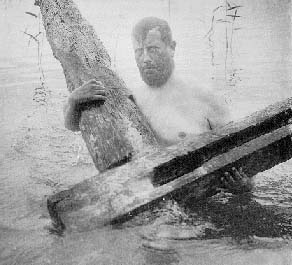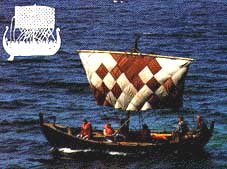The Bulverket Boat
Regarding the character of the place it is hardly surprising that Arvid Zetterling in the 1920s also found pieces from three different boats. The biggest of them seems to have been approximately 10 metres long, clinker built and of Nordic type. It was a sailing vessel but had no keelson. Instead the mast was set in a hole in one of the frames. The boat has also been regarded as wooden nailed (Cederlund 1975, Varenius 1979). Because of this, the boat, and also the site as a whole has been discussed as a product of Slavonic or Baltic builders (Westerdahl 1989). But whether the boat really was wooden nailed is debatable. Zetterling does in fact mention several times that he has seen traces on the hull planks of iron clinker nails. The Bulverket boat has also provided the basis for a famous Viking ship reconstruction called "Krampmacken" (see Nylén 1987).
In 1990, in the same area of the site that the Major found the boat timbers, three frames were found that were from the same boat. The strange thing is that it seems that these frames had been cut, so apparently the boat was intentionally destroyed before sinking. C14 analysis on the parts that were taken up in the 1930’s had given a surprisingly young date (see Bendegard 1992:11) but new dendrochronological dates indicate that the boat is contemporary with the rest of Bulverket, 1130s. Södertörns Högskola The text is an extract from the report Bålverket – om samhälls förändring och motstånd med utgångspunkt från det tidigmedeltida Bulverket i Tingstäde träsk på Gotland. (diss. Riksantikvarieämbet 1995). This page published Nov '99, rev jan '04 |


 Back to Nordic Underwater Archaeology
Back to Nordic Underwater Archaeology